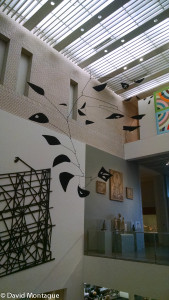Introduction to MobilesBackgroundMobiles are a form of art called “kinetic sculpture.” This simply means that the artwork is able to move. Mobiles typically are hung from above or balanced on a stand. The term “mobiles” was first applied to the work of American sculptor Alexander Calder (1898-1976), to help describe the art form as it emerged in the broader modern art movement. His friend and artistic cohort, Marcel Duchamp, coined the term, which in his native French was a pun meaning motive and motion. Calder can be seen as the inventor of the mobile and, as one of the most popular American sculptors, he was also responsible for their growth in popularity. Calder cited several inspirations for the inception of his mobiles: a red sunrise accompanying a full moon while working on a ship off of Guatemala, the kinetic modern dance of a dancer he admired, and a visit to his friend Piet Mondrian’s studio where he suggested the abstract art would look even more striking if it were in motion. He recalled thinking after his Mondrian visit “Why not plastic forms in motion? Not a simple translatory or rotary motion but several motions of different types, speeds and amplitudes composing to make a resultant whole. Just as one can compose colors, or forms, so can one compose motions” (Alexander Calder, by Jacob Baal-Teshuva, 2002, p.64). Calder provided his own definition of a mobile that remains fundamentally accurate: “A mobile is an abstract sculpture made chiefly out of sheet metal, steel rods, wire, and wood. Some or all of these elements move, propelled by electric motors, wind, water or by hand” (Baal-Teshuva, p.47). His works range from small to truly monumental, including well-known works in the atriums of the National Gallery of Art and the Hart Senate Office Building. In Minnesota, where I live, his mobile “Ahab” at the Minneapolis Institute of Art is a popular and often admired work. I distinctly remember being captivated by “Ahab” at an early age on a school field trip, thinking this was way more interesting than non-moving art. |
 Alexander Calder, Vertical Foliage, 1941 Alexander Calder, Vertical Foliage, 1941
|
|||
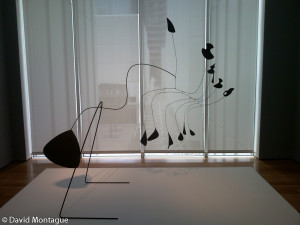 Alexander Calder, Spider, 1939 |
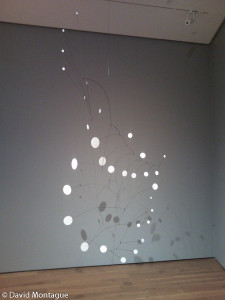 Alexander Calder, Snow Flurry I, 1948 |
|||
| As mentioned, mobiles are a form of kinetic sculpture. Kinetic sculpture can be defined as three dimensional art that employs movement in its function or presentation. Kinetic art began as a reaction to (or rebellion against) the norms of traditional, motionless art. Kinetic art is a relatively new field, gaining popularity/ recognition in the mid-twentieth century, and is still going strong today. Kinetic sculpture now includes many forms of movement—mechanized, biomorphic, computerized, virtual and elemental. The art form has evolved to encompass more than just mobiles, as many varieties of visual art have embraced movement. Over the years, there have been many kinetic sculptors that have made mobiles, though none have gained the level of notoriety of Calder. Please see my blog posts for more examples of contemporary kinetic art. | ||||
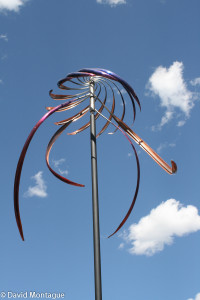 Kinetic Sculpture, Mark White |
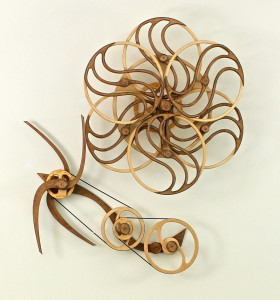 Variation II Wave, David C. Roy |
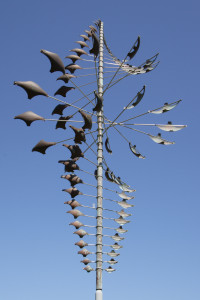 Whirligig, Lyman Whitaker |
||
Applications of MobilesPeople often find mobiles relaxing, meditative, and calming. They create perpetual visual interest with their ever changing form. Today mobiles are still appreciated as a form of fine art, but they have also been embraced as a nursery item for infants and children, which is how many people are familiar with mobiles. Nonetheless, fine art mobiles and kinetic art are showcased in a multitude of museums and galleries, and many pieces by Calder, George Rickey, and others have become remarkably valuable. Mobiles also have an intellectual appeal. As the story goes, Albert Einstein once spent nearly an hour watching a Calder mobile at the Museum of Modern Art in New York and commented that he wished he had thought of it. To be sure, Newtonian physics, fulcrums and levers, and centripetal and centrifugal force are all at work; yet the artistry is in the form the physics take. Mobiles bring movement and structure to spaces that were previously voids. Think about it: your walls space is decorated and may be even be full, but I bet you still have plain, bare ceilings. That space is available; why not fill it with art? Mobiles are perfect for a home’s common areas or bedrooms. They work great in offices, lobbies, and public spaces. Given the flexibility of a mobile’s scale, they can be as small as a desktop accessory or monumentally fill a large public space, and everything in between. Certain features benefit a mobile’s location. The biggest advantage would come from gentle air currents to initiate movement (e.g., a room with a ceiling fan, HVAC vents, opening windows/doors, or natural drafts). High ceilings, though not required, can give the mobile more space to operate. Mobiles also benefit from and interact with ambient light; the cast shadows can be as interesting as a mobile itself. A final point about mobiles, I find that they are terrific conversation pieces. They are different, they get noticed, and people remark about them. As art that stands out, mobiles are outstanding. Recommended Reading/References
|
||||

